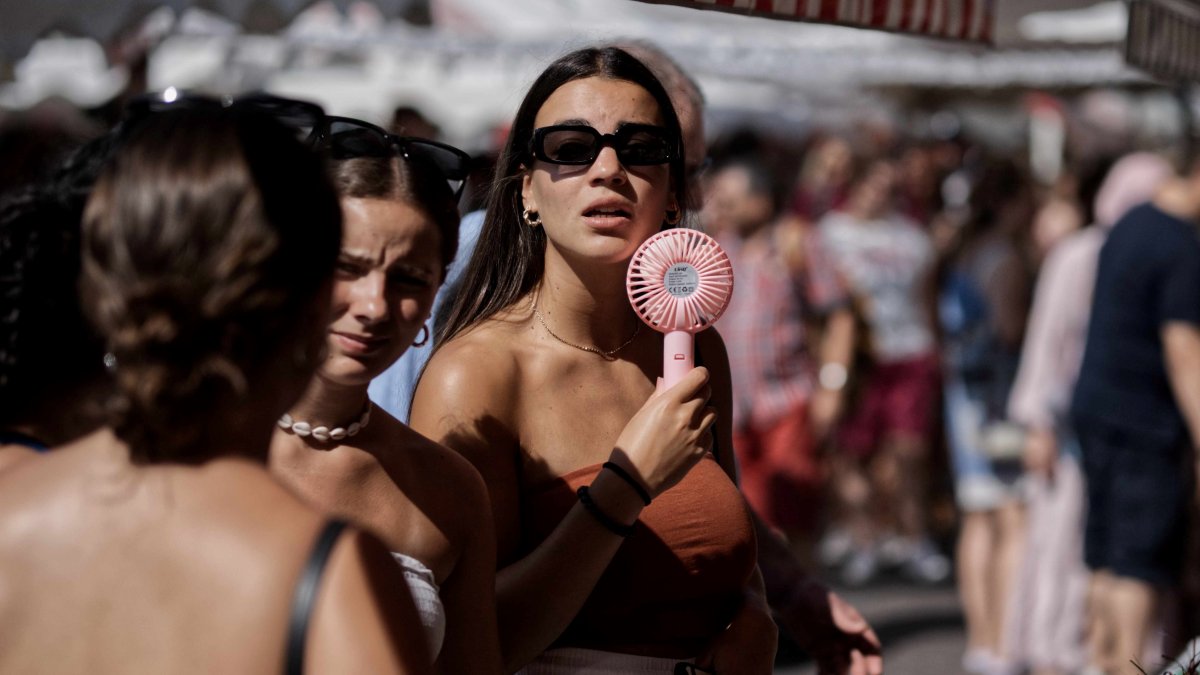From city subways to Southern cookouts to Midwestern music festivals, mini portable fans have rapidly become summer mainstays to mitigate the sweltering heat.
While the gadget (and the weather) may be hot, experts say the reasons for the popularity are not: climate change and fast fashion.
Long popular in humid climates like Asian countries, the mini blasters have proliferated in the West thanks to TikTok and platforms like Amazon, Shein and Temu.
As fast fashion has grown, so too have fast accessories, experts say.
Typically under $10 — the price of a faux leather belt, plastic sunglasses or synthetic jewelry — the battery- or USB-powered personal fan comes in a variety of styles: Users can wear it around their necks, install it in their car and even clip it on their handbag to accompany their prized Labubu.
The rapid growth of affordable accessories at online retailers like Temu and Shein, where fans cost as little as $4, is a selling point particularly for cash-strapped Gen Z buyers, said Sheng Lu, an assistant professor of fashion and apparel studies at the University of Delaware.
“The bigger picture behind the portable fan boom is how the popularity of fast fashion is spreading to accessories today,” Lu said. “It’s this kind of affordability and accessibility that facilitates expansion in the market.”
The price could increase at the end of the month with the end of a tariff exemption for lower-cost goods coming into the U.S.
The global personal fan market is set to surpass $1 billion by 2033, nearly doubling its current value, according to market research firms. In the U.K., consumers bought 7 million portable mini fans in the past year.
Google searches for portable fans have increased steadily over the past decade, peaking in June as intense heat waves blanketed the central and eastern U.S. The states with the highest search interest in the last three months are all in the sweltering South: Louisiana, Mississippi, Alabama, Georgia and South Carolina, among others.
On TikTok, “portable fans” is the third most used hashtag for videos in the “Tech & Electronics” category, most popular in Malaysia, then in the U.S.
On social media overall, images and videos of the product seem inescapable. And the rise of mini fans is demonstrating how climate might be influencing fast-fashion trends, said Tracie Tung, associate professor of fashion design and merchandising at California State University, Northridge.
New data from UCSD and the Scripps Institute shows a record-high concentration of CO2, rising faster than ever. Meteorologist Chase Cain talks with the lead scientist about the acceleration of climate change and the future of this critical data.
“This is not a new invention,” she said. “Now they’re just designed as a fashion piece.”
Some influencers have leveraged the trend to launch their own brands. Remi Bader, who has more than 2 million followers on TikTok, released a stylish new fan last year that clips onto a phone and comes equipped with selfie lights.
Kisha Peart, a creator based in New York City, posted a TikTok about the mini blasters in March that took off once it got hot. From that one viral video, Peart said people bought between 200 and 400 units of the featured fan from TikTok Shop; she earned commission on each purchase.
Peart said the mini fan has become an indispensable companion on her commute to work, as the air conditioning on the bus isn’t always functional.
“I just needed a way to stay cool, and paper fans just blow hot air,” she said. “The portable fan with five speeds has really been a game changer.”
The Asia-Pacific region, where summers are known to be extremely humid, accounted for 55% of the growth of the global portable fans market and has been its largest revenue contributor, generating nearly $140 million in 2021, according to the market research firm Allied Market Research. That the trend has spread from Asia to Europe and America didn’t shock Tung, as much of the world, from South Korea and Japan to the Nordic countries, has experienced deadly, unprecedented temperatures this summer.
The Shenzhen-based company JisuLife, which has emerged as a leader in the personal fan market, has sold 30 million units of the product globally since 2018. JisuLife’s mini fans fall at the higher end of the cost spectrum, with some models priced at more than $80.
JisuLife has said it has different marketing strategies for Southeast Asia and North America, its two biggest markets. The company said North American buyers tend to prioritize functionality, while in Southeast Asia, style and aesthetics are paramount, so the strategy is to collaborate with local influencers and ambassadors to boost brand appeal.
At the same time, the handheld fan boom also raises serious environmental concerns. Overconsumption of cheap products, especially those made of hard-to-recycle materials like batteries and plastic, creates waste. The U.K.-based nonprofit Material Focus estimated that roughly 3.5 million fans have been discarded or forgotten over the past year.
“How do we deal with these fans after summer ends?” Lu said. “What happens to these hundreds of thousands of items that people might see as ‘disposable’?”
Jocelyn Shek contributed.



